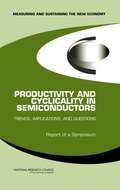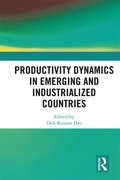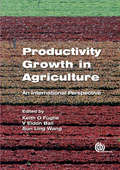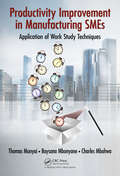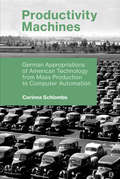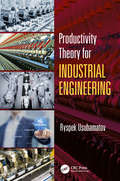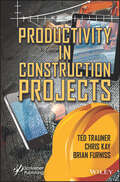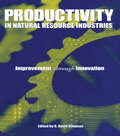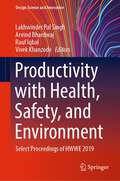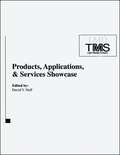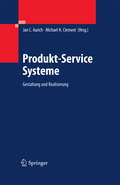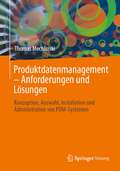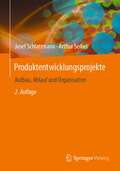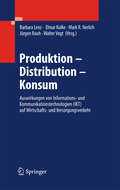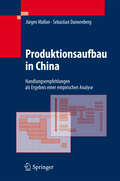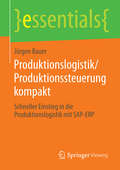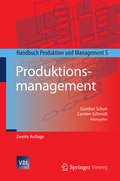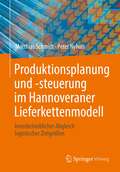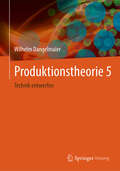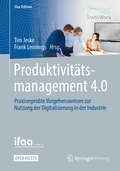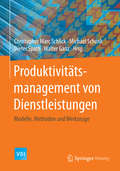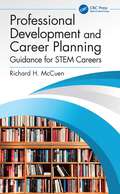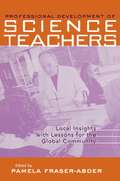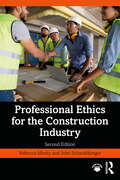- Table View
- List View
Productivity And Cyclicality In Semiconductors: Trends, Implications, And Questions
by Committee On Measuring Sustaining the New EconomyHosted by Harvard University’s Kennedy School of Government, this symposium brought together leading technologists and economists to review technical challenges facing the semiconductor industry, the industry’s business cycle, the interconnections between the two, and the implications of growth in semiconductors for the economy as a whole. This volume includes a summary of the symposium proceedings and three major research papers. Topics reviewed encompass the industry technology roadmap, challenges to be overcome to maintain the trajectory of Moore’s Law, the drivers of the continued growth in productivity in the U.S. economy, and economic models for gaining a better understanding of this leading U.S. industry.
Productivity Dynamics in Emerging and Industrialized Countries
by Deb Kusum DasThe world, of late, has seen a productivity slowdown. Many countries continue to recover from various shocks in the macro business environment, along with structural changes and inward looking policies. In contemporary times of growth slumps, various exits and protectionist regimes, this book engages with the study of productivity dynamics in the emerging and industrialized economies. The essays address the crucial aspects, such as the roles of human capital, investment accounting and datasets, that help understanding of productivity performance of global economy and its several regions. This book will be of interest to academics, practitioners and professionals in the field of economic growth, productivity and development studies. This will also be an important reference on empirical industrial economics in both India and the world.
Productivity Growth in Agriculture
by Ms Sun Ling Wang Eldon Ball Dr Keith O FuglieIncreasing food prices have renewed concerns about long-run agricultural demand and supply in the global economy. This book looks at results, methods, and data on international agricultural productivity for a better understanding of long-run trends and the policies that determine them. By presenting an international assessment of total factor productivity growth in agriculture, including up-to-date empirical analysis for developed and developing countries and regions, it provides a response to the rising global scarcity of agricultural production. Essential reading for researchers, policy makers and students.
Productivity Improvement in Manufacturing SMEs: Application of Work Study
by Charles Mbohwa Thomas Thinandavha Munyai Boysana Lephoi MbonyaneThis book focuses on the application of workstudy in productivity of manufacturing SMEs locally and abroad and also explores various industrial problems which face manufacturing SMEs in developing and underdeveloped countries in the rest of the world. Low productivity is currently a serious challenge facing manufacturing SMEs, where these SMEs are operating below expected production output levels which makes it difficult for them to compete in the global market. SMEs are the engine drivers of economic growth, one of which is manufacturing. The challenge is that government from various countries in developing and underdeveloped countries, mandated agencies in their respective areas, to ensure that there is economic progress for these SMEs, but productivity remains low in the manufacturing SMEs. When SMEs do not perform well, productivity of manufacturing SMEs declines and unemployment increases. Thus, an increase in unemployment results in a drop of GDP in the country and can become a global and economic crisis. This book describes a process which enables the reader to use effective knowledge that addresses problems facing the productivity of manufacturing SMEs such as work study tools and case studies and provides solutions and applications to improve the running of the manufacturing SMEs in growing their productivity.
Productivity Machines: German Appropriations of American Technology from Mass Production to Computer Automation (History of Computing)
by Corinna SchlombsHow productivity culture and technology became emblematic of the American economic system in pre- and postwar Germany.The concept of productivity originated in a statistical measure of output per worker or per work-hour, calculated by the US Bureau of Labor Statistics. A broader productivity culture emerged in 1920s America, as Henry Ford and others linked methods of mass production and consumption to high wages and low prices. These ideas were studied eagerly by a Germany in search of economic recovery after World War I, and, decades later, the Marshall Plan promoted productivity in its efforts to help post–World War II Europe rebuild. In Productivity Machines, Corinna Schlombs examines the transatlantic history of productivity technology and culture in the two decades before and after World War II. She argues for the interpretive flexibility of productivity: different groups viewed productivity differently at different times. Although it began as an objective measure, productivity came to be emblematic of the American economic system; post-World War II West Germany, however, adapted these ideas to its own political and economic values. Schlombs explains that West German unionists cast a doubtful eye on productivity's embrace of plant-level collective bargaining; unions fought for codetermination—the right to participate in corporate decisions. After describing German responses to US productivity, Schlombs offers an in-depth look at labor relations in one American company in Germany—that icon of corporate America, IBM. Finally, Schlombs considers the emergence of computer technology—seen by some as a new symbol of productivity but by others as the means to automate workers out of their jobs.
Productivity Theory for Industrial Engineering (Systems Innovation Book Series)
by Ryspek UsubamatovSince the time of the Industrial Revolution, manufacturing industries have accumulated a huge experience in creating different machines and systems for fabricating various goods, work parts, and products. All these diverse machines and systems, with different designs to solve pivoted economic problems, increased the productivity rate of manufacturing processes and generated high-quality products. In the area of productivity theory for industrial engineering, there are numerous publications that describe the fundamental approaches and the mathematical models of productivity rate for the different designs of industrial machines and systems. Known theories consider the physical productivity rate as the number of products fabricated over a given time (ASME) that is a component of economic productivity. However, known mathematical models are simplified with assumptions and not well developed analytically, which can lead to severe errors in computing the output of manufacturing systems. Modern industrial machines and systems are complex in design and in structure with serial, parallel, and serial-parallel arrangements, and any failure of any component leads to downtime of expensive production systems. For this reason, industries need a productivity theory that enables accurate predicting of the output of manufacturing systems at the preliminary stages. Key features Offers fundamental principles of productivity theory for industrial machines and systems based on mathematics, technology, design, reliability, probability, and management Presents the conceptual principles of productivity theory for industrial machines and systems Provides methods for computing productivity losses in real industrial environments Closes the gap between theory and practice for computing productivity rates of manufacturing systems Incudes a comparative analysis of productivity rates for manufacturing systems of serial, parallel, and serial-parallel arrangements Productivity Theory for Industrial Engineering presents analytical approaches and methods to define maximal productivity rates, optimal machining regimes, and optimal structure of manufacturing machines and systems based on the parameters of technological processes, structural design, reliability of mechanisms, and management systems. This book uses productivity theory for solving productivity problems and can also be used for complex approaches for sustainable improvement of production processes.
Productivity in Construction Projects
by Ted Trauner Brian Furniss Chris KayPRODUCTIVITY IN CONSTRUCTION PROJECTS From planning/design to post-construction, this valuable guide provides the construction industry the key to understanding the importance of properly tracking and measuring productivity, resulting in increased efficiency and profitability for contractors, subcontractors, owners, civil and construction engineers, and attorneys. Productivity in Construction Projects anticipates and answers the questions of owners, contractors, sub-contractors, and construction professionals to avoid cost overruns in a specific area of work, or when activities are taking more resources to perform than planned. Packed with real-world case studies, Productivity in Construction Projects’ thirteen chapters move beyond the symptoms and provide a remedy. This book provides a comprehensive look at how to: Complete more projects on time and budget, and earn greater profits and future business. Track and analyze productivity on construction projects, and quantify additional costs resulting from productivity losses. Select the right experts and attorneys should litigation or arbitration occur, and employ credible and reliable methods of analysis. Solve problems on the project instead of incurring lengthy and costly litigation or arbitration.
Productivity in Natural Resource Industries: Improvement through Innovation
by R. David SimpsonSeveral senior natural resource analysts study the role played by innovation, particularly technological innovation, in the pursuit of heightened productivity. Increasing the output of a given input improves a firm‘s bottom line, makes it more competitive internationally, and reduces the potential for resource depletion and shortages. Thus, high productivity is a necessary ingredient of economic prosperity. This book illustrates the importance of technological innovation in achieving an acceptable level of output and efficiency. In this important new offering, a team of resource scholars describes and chronicles the development of recent innovations in selected natural resource industries. The authors also reveal the causes, sources, and net effect of such innovation on productivity. In all of these sectors productivity has increased considerably since the early 1980s, although the level of improvement varies across industries. To what degree did technological innovation contribute to that increase? Individual detailed case studies detail important innovations in America‘s coal, petroleum, copper, and forest industries. The primary focus is on extraction and production technologies, although the existence and importance of innovation in other areas such as management technique also enter the picture. For example, the combination of new technology with restructuring seems to have breathed new life into a floundering U.S. copper industry. The authors describe the origin and diffusion of important innovation, and the concluding chapter quantifies the net effect of such innovation on productivity.
Productivity with Health, Safety, and Environment: Select Proceedings of HWWE 2019 (Design Science and Innovation)
by Rauf Iqbal Vivek Khanzode Arvind Bhardwaj Lakhwinder Pal SinghThis volume comprises select proceedings of the International Conference on Humanizing Work and Work Environment organized by the Indian Society of Ergonomics (HWWE2019). The book presents research findings on different areas of ergonomics for developing appropriate tools and work environment considering capabilities and limitations of working people for maximum effectiveness on their performance. This volume will be of interest to academics, professionals and practitioners in the field of ergonomics.
Products, Applications, and Services Showcase
by The Minerals Metals Materials SocietyThis collection of short technical and product presentations is from the Products, Applications, and Services Showcase, a symposium focusing on the commercial aspect of the materials science and engineering professions.
Produkt-Service Systeme
by Jan C. Aurich Michael H. ClementBisher haben sich produzierende Unternehmen auf Entwicklung, Produktion und Vertrieb von Sachprodukten konzentriert, inzwischen fragen Kunden jedoch zunehmend komplette Problemlösungen nach. Unternehmen stehen vor der Herausforderung, den Wandel zum Full-Service Provider zu vollziehen. In dem Band wird ein Managementsystem zur Unterstützung von Planung, Entwicklung, Konfiguration und Realisierung von Produkt-Service Systemen (PSS) im erweiterten Wertschöpfungsnetzwerk vorgestellt und Methoden zur Organisation sowie zum Kompetenzerwerb aufgezeigt.
Produktdatenmanagement – Anforderungen und Lösungen: Konzeption, Auswahl, Installation und Administration von PDM-Systemen
by Thomas MechlinskiProduktdatenmanagement (PDM) ist ein umfassendes, in seiner Ganzheit schwer zu überblickendes Thema. Bei der Betrachtung gängiger PDM-Systeme stellt sich oft die Frage, warum bestimmte Funktionen und Eigenschaften existieren und wie sich damit typische Fragestellungen des Produktentstehungsprozesses (PEP) lösen lassen. Dieses Buch formuliert Anforderungen, die die heute am Markt erhältlichen PDM-Systeme abdecken und erklärt, auf welche Weise die Anforderungen erfüllt werden können. Der Katalog an Anforderungen ist auf die industrielle Praxis im Umfeld der Serienfertigung von Produkten zugeschnitten und kann auch als Basis für die Einführung von PDM-Systemen genutzt werden.Das Buch richtet sich an IT-Verantwortliche, die sich mit der Einführung oder dem Ausbau von PDM-Systemen beschäftigen. Es ist solchermaßen detailliert, dass die Anforderungen und Lösungen in Bezug auf einen konkreten Einsatz beurteilt werden können. Die beschriebenen Lösungsansätze können für die Implementierung in einem Unternehmen übernommen und bedarfsgerecht verändert oder ausgebaut werden. Der Ansatz ist so gewählt, dass dieses Buch auch für Studierende als Basis für das Verständnis von PDM-Systemen dienen kann.
Produktentwicklungsprojekte - Aufbau, Ablauf und Organisation
by Josef Schlattmann Arthur SeibelZiel dieses Handbuchs ist die Vermittlung von nutzbringenden Kenntnissen, Fähigkeiten und Verhaltensweisen, die ein in der Produktentwicklung/Projektleitung verantwortlich tätiger Ingenieur vielfach braucht, die aber in der üblichen Ingenieurausbildung zu wenig Beachtung finden. Sie greifen über das Fachwissen hinaus in den menschlichen Bereich hinein, weil technischen und/oder organisatorischen Schwierigkeiten faktisch immer menschliche Probleme zugrunde liegen.
Produktion - Distribution - Konsum
by Elmar Kulke Barbara Lenz Jürgen Rauh Mark R. Nerlich Walter VogtDie zunehmende Bedeutung von Informationsflüssen für die Wertschöpfung geht einher mit einer wachsenden Kohärenz der Wertschöpfungsketten. Kenntnisse darüber sind für die strategische Planung in der Politik wie in Unternehmen gleichermaßen wichtig. Die Beiträge des Buchs untersuchen die Auswirkungen von Informations- und Kommunikationstechnologien auf Güter- und Informationsflüsse zwischen Herstellern und Endverbrauchern. Dazu werden Güter- und Informationsflüsse entlang von Produktions- und Distributionsprozessen dargestellt und analysiert.
Produktionsaufbau in China
by Jürgen Mallon Sebastian DannenbergAusgehend von den Erfahrungen in fast 50 deutschen Unternehmen stellen die Autoren Konzepte und erfolgskritische Elemente für den Produktionsaufbau in China vor und bewerten diese. Aus der Typisierung der unterschiedlichen Vorgehensmodelle und einer Unternehmensbewertung leiten sie Erfolg versprechende Vorgehensweisen ab und beschreiben die erforderlichen Maßnahmen. Die Handlungsempfehlungen orientieren sich an Kriterien der Nachhaltigkeit, Hinweise für einen Schnellstart im chinesischen Markt werden ebenfalls gegeben.
Produktionslogistik/Produktionssteuerung kompakt: Schneller Einstieg in die Produktionslogistik mit SAP-ERP (essentials)
by Jürgen BauerDieses kompakte Buch bietet dazu eine leicht verständliche, an einem durchgängigen Fallbeispiel dargestellte Einführung in die Produktionslogistik und - steuerung . Prozesse, Datenorganisation und Methoden werden am Beispiel des SAP-ERP-Systems erläutert. Dies ermöglicht Ingenieuren, Controllern und Logistikern einen fundierten Überblick und erfolgreichen Einstieg in das rechnergesteuerte Produktions- und Materialmanagement.
Produktionsmanagement: Handbuch Produktion und Management 5 (VDI-Buch)
by Günther Schuh Carsten SchmidtDas mehrbändige Handbuch Produktion und Management richtet sich an Fach- und Führungskräfte technologieorientierter Unternehmen, die nach methodischer Unterstützung suchen, ebenso wie an Wissenschaftler und Studierende der Ingenieurwissenschaften und der Betriebswirtschaftslehre.Das Produktionsmanagement beinhaltet sämtliche Aufgaben zur Gestaltung, Planung, Überwachung und Steuerung eines Produktionssystems sowie der betrieblichen Ressourcen Mensch, Maschine, Material und Information. Dieser 5. Band ordnet die Kernprozesse der Produktionsprogrammplanung, des Auftragsmanagements, der Produktionsbedarfsplanung, der Eigenfertigungs- sowie der Fremdbezugsplanung und -steuerung in den Gesamtzusammenhang des Produktionsmanagements ein. Dabei wird der Gestaltungsspielraum innerhalb dieser fünf Kernprozesse aus den Perspektiven der Aufgaben, Methoden und Verfahren sowie aus Sicht der fertigungstypbezogen differenzierten Prozesse detailliert betrachtet.
Produktionsplanung und -steuerung im Hannoveraner Lieferkettenmodell: Innerbetrieblicher Abgleich logistischer Zielgrößen
by Peter Nyhuis Matthias SchmidtDas Hannoveraner Lieferkettenmodell ist ein Rahmenmodell für die produktionslogistischen Prozesse in Unternehmen. Das Buch stellt seine Zielsysteme in den Kernprozessen der unternehmensinternen Lieferkette Beschaffung, Produktion und Versand dar und zeigt Wechselwirkungen zwischen den teilweise konträr ausgerichteten Zielgrößen auf.Anhand des Hannoveraner Lieferkettenmodells werden die verschiedenen Hauptaufgaben und Aufgaben der Produktionsplanung und -steuerung (PPS) systematisch beschrieben und in einen Gesamtkontext gebracht. Oft werden durch die Erfüllung der PPS-Aufgaben einige Zielgrößen positiv und andere negativ beeinflusst. Aufgrund dieser gegensätzlichen Wirkung der Erfüllung der PPS-Aufgaben sind unternehmerische Entscheidungen zu treffen. Hierfür werden in diesem Buch die zentralen Zielkonflikte der PPS herausgearbeitet und die Wirkung der PPS-Aufgaben auf die Zielgrößen veranschaulicht.So ermöglicht dieses Buch eine Betrachtung der Wirkzusammenhänge zwischen der Produktionsplanung und -steuerung und den logistischen Zielgrößen in der unternehmensinternen Lieferkette.
Produktionstheorie 5: Technik entwerfen
by Wilhelm DangelmaierIn dem mehrbändigen Werk zur „Produktionstheorie“ sollen erstmalig die heute aus der Praxis geborenen Produktionsmodelle und –verfahren mathematisch begründet hergeleitet und so auch der Produktionswirtschaft eine wissenschaftliche Grundlage gegeben werden. Dem „wir haben unser Unternehmen halt so organisiert und das hat sich bewährt“ soll eine konstruktivistische Sicht beiseite gestellt und so die vielen deskriptiv angelegten „Fabrikbetriebslehren“ abgelöst werden.Im vorliegenden Band 5, „Technik entwerfen“ wollen wir eine Theorie des Entwerfens von Technik angehen und uns Gedanken über das Denken und Handeln des Ingenieurs machen. Dieses Denken und dieses Handeln sind immer rekursiv: Wir entwerfen ein Technisches System‘ zur Herstellung eines Technischen Systems‘‘ zur Herstellung eines Technischen Systems‘‘‘. Das könnte bspw. das Entwerfen eines Produktionssystems zur Herstellung von Spritzgussmaschinen zur Herstellung von Haushaltföhns sein, wenn dabei initial nur festliegt, welchen Föhn der Markt letztendlich verlangt. Natürlich gibt es hier eine riesige Bandbreite möglicher Lösungen; wir brauchen nur eine, die für uns beste. Den dafür notwendigen Entscheidungs- und Auswahlprozess soll dieses Buch vorbereiten und/oder begleiten.
Produktivitätsmanagement 4.0: Praxiserprobte Vorgehensweisen zur Nutzung der Digitalisierung in der Industrie (ifaa-Edition)
by Frank Lennings Tim JeskeIn diesem Open-Access-Buch sind aktuelle Praxisbeispiele und Handlungsempfehlungen zur Gestaltung von Arbeit und Produktivität in der digitalisierten Welt beschrieben. Die Beispiele wurden von Unternehmen und wissenschaftlichen Instituten in mehreren Forschungsprojekten entwickelt und in der Praxis erprobt. Jedes Praxisbeispiel umfasst konkrete Bedarfe und Ziele, ein schrittweises Vorgehen, die Auswirkungen auf die Arbeitsgestaltung und die Produktivität sowie die zu beachtenden Erfolgsfaktoren. So sind aktuelle Gestaltungslösungen für Unternehmen beschrieben, die die Potenziale der Digitalisierung für die Arbeitswelt und das Produktivitätsmanagement praxisnah aufzeigen.
Produktivitätsmanagement von Dienstleistungen: Modelle, Methoden und Werkzeuge (VDI-Buch)
by Christopher Marc Schlick Michael Schenk Dieter Spath Walter GanzDas Buch richtet sich an Dienstleistungsmanager und -planer und beinhaltet ein Kompendium von Modellen, Methoden und Werkzeugen zur Messung, Bewertung und Steuerung der Produktivität von wissensintensiven Dienstleistungen. Neben einer modellbasierten, ganzheitlichen Betrachtung der Produktivität von Dienstleistungen werden die in empirischen Studien identifizierten Stellgrößen vorgestellt und deren Wechselwirkungen in einem System-Dynamics-Modell veranschaulicht. Des Weiteren wird eine Methode zum partizipativen Projektcontrolling eingeführt. Anhand von Fallbeispielen von international agierenden Unternehmen werden innovative Konzepte und Softwareprototypen demonstriert, mit denen auch schwach strukturierte Arbeitsprozesse, wie sie für wissensintensive Dienstleistungen typisch sind, effektiv modelliert, simuliert und optimiert werden können. Die dargestellten Modelle, Methoden und Werkzeuge sollen dem Leser als Unterstützung dienen, komplexe, wissensintensive Dienstleistungen optimal zu planen, während der Erbringung erfolgreich zu steuern und abschließend zu bewerten. Als Innovationsführer in verschiedenen wertschöpfungsstarken Branchen ist Deutschland insbesondere auf wissensintensive Dienstleistungen dringend angewiesen. Die Wettbewerbsfähigkeit der in diesem Segment tätigen Unternehmen ist bei steigendem Lebensstandard der Beschäftigten und einem latenten Mangel an Fachkräften vor allem durch eine Steigerung der Produktivität zu sichern.
Professional Burnout: Recent Developments In Theory And Research (Routledge Library Editions: Human Resource Management Ser.)
by Wilmar B. Schaufeli, Christina Maslach and Tadeusz MarekThis book provides a complete presentation of the past, present, and future of professional burnout by bringing together a set of original papers from an international group of leading scholars on burnout.
Professional Development and Career Planning: Guidance for STEM Careers
by Richard H. McCuenUndergraduate students in almost all disciplines experience curricula dominated by technical foundations, but lacking many of the "soft" topics that the students will need in order to be fully prepared to practice professionally after graduation. Professional Development and Career Planning: Guidance for STEM Careers provides the information that will enable readers to develop a more complete education and ready them for the workplace. It helps readers recognize the importance of topics such as mentoring, developing professional attitudes, communication skills, codes of conduct, ethics, becoming knowledgeable about various aspects of professional life, and more. Each chapter of the book provides the necessary definitions, hypothetical but relevant case studies, methods and practices that can be used to identify relevant professional weaknesses, and ways to overcome each of them. This book serves as an ideal reference for any undergraduate student in the STEM field. Helps readers recognize the importance of topics such as mentoring, developing important professional attitudes, and becoming knowledgeable about aspects of professional life that are not an integral part of the technical component of any curriculum. Identifies the attitudes, abilities, and skills that will be needed to optimally meet professional responsibilities. Provides information about the use of alternative methods of thinking to achieve success in problem-solving, with special emphasis on imaginative-based methods of thinking for multi-dimensional problems.
Professional Development in Science Teacher Education: Local Insight with Lessons for the Global Community (Reference Books in International Education)
by Pamela Fraser-AbderThis book explores global issues in the professional development of science teachers, and considers classroom applications of teacher training with a comparative lens. The twelve studies collected in this volume span five continents and vastly differing models of teacher education. Carefully detailing the social and cultural contexts for the teaching of science, this is a guidebook for anyone concerned with equity and reform in professional development.
Professional Ethics for the Construction Industry
by John Schaufelberger Rebecca MirskyThis second edition of Professional Ethics for the Construction Industry empowers a new generation of built environment professionals to navigate the ethical challenges confronting them at every stage of a project, from the initial bid to its completion and beyond. Authored by a pair of veteran educators and industry professionals, this textbook introduces ethical dilemmas aspiring construction professionals will face on the job—and the critical thinking skills to reason their way out of them. Written to meet curriculum requirements for all levels of construction education, this book explores ethics specific to the construction industry, illustrated by detailed and realistic case studies. All-new chapters on privacy, cutting-edge technologies, and pandemic-era worker protections complement chapters on perennial ethical issues surrounding the environment, client relationships, and more. Features include: • Completely revised and updated to reflect changes in construction technology, workforce composition, and working environments. • Updated to include new chapters on social media, privacy and technology, and construction during a disease outbreak or natural disaster. • Ideal reading for courses in professional ethics, leadership, construction law, workforce readiness, and continuing education. • Downloadable instructor's manual with commentary on scenarios provided at the end of each chapter. As vital on the jobsite as in the classroom, Professional Ethics for the Construction Industry guides aspiring design and construction professionals through the thorniest on-the-job conundrums.
